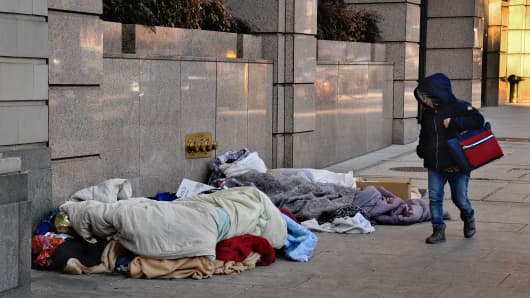Driving down Constitution Avenue past the Federal Reserve building in the nation's capital, you can’t miss the crowd of homeless people gathered in the shadow of the austere building.
The contrast between the place where U.S. monetary policy is set and the place where those who haven’t a cent congregate illuminates the darkening economic reality for so many in America.
The Fed is worried about the economy overheating. All the conventional numbers tell us the economy is strong. Earlier this month, it was announced the economy added 213,000 jobs in June, and monthly unemployment was 4 percent. Second-quarter GDP growth is being forecast at 3.8 percent. The S&P 500 is up about 280 percent since 2009, according to the St. Louis Fed.
All these measures support the notion that times are good. They tell us most Americans should be doing better than in past generations. They tell us our economic policy is sound, and the status quo is working.
But a different picture emerges looking at the homeless people by the Fed building and visiting my hometown, York, Pennsylvania, where wages have stagnated and factories have closed. So I’ve been working with a Yale economist, Philip Kalikman, to uncover what’s really going on in America. What we’ve found is that there’s an increasing imbalance between the haves and have-nots.
Though total aggregate national income is up somewhat, real wage gains have at best stagnated for most. More than 50 percent of income gains from 2009 to 2015 went to the wealthiest 1 percent of Americans, according to Emmanuel Saez of the University of California at Berkeley. The New York Times reported in 2016 that the median American family still makes hardly more than in the 1990s.
Since 2000, costs of essentials have increased dramatically, according to the St. Louis Fed. Educational costs are up 132.8 percent, housing 59.5 percent, healthcare 53.4 percent, and food 51.6 percent. Over the same period, real median wages for full-time employed earners are up only 4.8 percent.
Consumer and student loan debts are replacing mortgage debt for many. Young people are so cash-constrained and crippled by debt that they are forming households later, delaying investment in homes and neglecting other productive investments in their futures, according to the New York Fed.
The weakened social safety net is having a profound effect. In 2009, families with poor credit experienced a destabilizing event, such as a medical issue or job loss, every 87 days. By 2016, they endured such an event every 30 days, according to a book by University of Pennsylvania professor Lisa Servon.
Yet families on net are working much harder, in large part because more families have two earners instead of one, according to UC Hastings College of the Law professor Joan Williams.
So if measures like GDP and unemployment are true, why are huge portions of middle- and low-income groups struggling?
The problem lies with the numbers. The common measures used to explain our economy’s health, from a macroeconomic perspective, paint a misleading picture. At the heart of the problem is the difference between the aggregate and the individual. If Bill Gates, whose net worth is north of $90 billion, moved into a struggling Detroit neighborhood, we would measure the average wealth in his new ZIP code as being phenomenally higher in the year he moved than in the year prior. But incomes for many – in Detroit, the per capita annual income is $15,562 – wouldn’t have changed.
This situation is characteristic of distributional inequality. The more unequal a distribution, the more measurements such as totals and averages are dominated by relatively few of the individuals in the distribution. No matter how happy or secure Bill Gates feels, his move to Detroit will not increase his ZIP code’s average reported sense of security or well-being.
This distributional effect masks important developments in Americans’ economic security. GDP and unemployment percentages as measures of our health are at the root of the problem. In reality, most Americans actually are poorer now than they were before.
There are a number of policy changes that are necessary to turn around the economic situation for middle- and lower-income people. We need to increase our infrastructure spending, which will have the double benefit of creating jobs and improving the highways, bridges and tunnels crumbling around us. We need to provide educational opportunities, including skills training and a focus on STEM, that don’t saddle families with debt and that do lead to actual well-paying jobs. And we need to support business competitiveness by, among other things, funding the Export-Import Bank of the United States; its funding decline has allowed good jobs to bleed abroad.
This brings us back to last month's jobs numbers. And GDP. And the stock market. They clearly tell us the economy is strong, but we need real facts that help our policymakers understand how our society is faring in this economy. We need the Fed and other governmental bodies to use new measures that bring the economic reality facing our country into focus. Because if policymakers can’t see there’s a problem, how will they know what to fix?
Eugene Ludwig is founder and chief executive officer of Promontory Financial Group. He was formerly comptroller of the currency under the Clinton administration.


